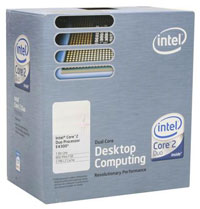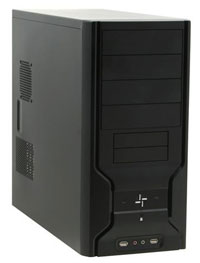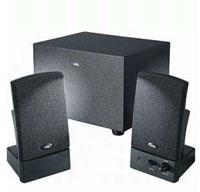Entry Level Intel
Our entry level Intel configuration contains many of the same components as the AMD configuration. The only actual changes are in the choice of motherboard and processor. However, trying to make the systems "equivalent" was simply not realistic. We could either cut the costs of the processor dramatically by going with an older Pentium D offering - not something we would recommend these days - or we end up spending more due to higher prices of Core 2 Duo parts. Intel should be releasing some additional budget offerings in the future, including some single core chips that use the Core architecture. Regardless, if you're looking at Intel-based computers these days we would invariably opt to spend the money and get a Core 2 Duo.
| Intel Entry Level System |
| Hardware |
Component |
Price |
Rebates |
| Processor |
Intel Core 2 Duo E4300 (1.80GHz 2MB Shared) - Retail |
$135 |
|
| Motherboard |
MSI G965M-FI (LGA 775 965G) |
$90 |
|
| Memory |
WINTEC AMPO 2x512MB DDR2-800 (5-5-5-12 3AMD2800-1G1K-R) |
$65 |
|
| Hard Drive |
Western Digital Caviar SE16 WD2500KS 250GB 16MB |
$70 |
|
| Optical Drive |
Lite-On 20X DVD+R LH-20A1P-185 |
$34 |
|
| Case |
RAIDMAX APEX ATX-802BP with 450W PSU |
$65 |
|
| Display |
Hanns-G JC-199DPB 19" 8ms (1280x1024) |
$184 |
$40 |
| Speakers |
Cyber Acoustics CA3001WB 14 watts 2.1 Speakers |
$24 |
|
| Keyboard and Mouse |
Microsoft Comfort Curve 2000 B2L-00047 |
$28 |
|
| Operating System |
Windows MCE 2005 or Vista Home Premium (OEM) |
$115 |
|
| Bottom Line |
|
$810 |
$770 |
 |
Given that price is a major consideration for any budget computer, there was really only one reasonable choice for the processor given the above statements. The Core 2 Duo E4300 is still more expensive than what we would generally classify as an entry level component, but that doesn't mean it isn't worth the money. In pretty much any benchmark you throw at it, the E4300 is going to end up faster than the Athlon X2 3600+ we used in our AMD configuration. Of course, if you were to go out and purchase a $135 AMD part, the performance advantage will likely swing the other way.
 |
Not only do you have to generally spend more money on the processor for the Core 2 Duo platform, but motherboards also tend to cost more than roughly equal offerings from the AMD camp. Since we're using integrated graphics for our entry level configurations, things get even trickier. The IGP offerings for socket AM2 are at present much better than the IGP offerings for socket 775. They perform better, and perhaps more importantly they do so while costing less money. That's not to say that you can't find inexpensive Core 2 Duo compatible motherboards; there are quite a few VIA chipset solutions. For overall quality and reliability, however, we prefer to avoid those if possible, as they can be a bit quirky at times. Motherboards are simply too critical of a component in our view.
Given the choices, we eventually decided to stick with the standard Intel G965 chipset. Graphics performance is subpar compared to the current AMD and NVIDIA offerings, but even then it's still sufficient for most tasks. Intense 3D gaming is not one of those tasks, and even at low resolutions and low detail settings there are so games that won't work properly on this chipset. The X3000 graphics core is supposed to be much improved over previous Intel solutions, but our own opinion is that it remains a lackluster offering. Outside of gaming, however, there are very few applications that require more graphics processing power.
 |
Looking at the G965 motherboards currently available, even the most basic models start at closer to $90, with some of the better equipped models costing as much as $130. The MSI G965M-FI we selected is one of the least expensive offerings but it still does quite well in the features department. Naturally the motherboard supports all Core 2 Duo processors currently available, though it lacks overclocking support in the BIOS at this time. This MSI board also includes FireWire support, something that our entry level AMD platform lacks.
The Gigabyte GA-965GM-S2 would be a better choice for IGP and overclocking, typically reaching moderate FSB speeds. The E4300 processor should be able to run at 2.4GHz (9x266) quite easily and perhaps even 3.0GHz (9x333). Overclocking certainly isn't our primary concern, but the low-end Core 2 Duo chips manage it so well that it deserves mention.
The remaining components are the same, and the bottom line is that the Intel configuration ends up costing about $70 more than the AMD setup. The base performance will definitely favor the Intel platform in processor tests, while graphics tests will favor the 690G IGP over the G965. If you were to spend the same amount of money on both platforms, you could move up to an Athlon X2 5000+ which would certainly put the AMD platform in the lead in virtually all benchmarks. Overclocking would still favor the Intel platform for CPU performance, but for your typical budget PC right now we would give the edge to the AMD platform offerings.














46 Comments
View All Comments
xsilver - Monday, April 23, 2007 - link
A quick mention of the possible headroom on the 2x1gb Jetram would have been nice?eg. does it overclock to cas 4? or does it OC to ddr900? or both? or none?
amking0 - Saturday, April 21, 2007 - link
with all the recent price cuts and rebates floating around, i've finally decided to leave my single core a64 system behind and do an upgrade to something along the following lines:e6600
650i board (probably)
2 gb corsair ddr2-800
old 7800 gt for the time being
just wanted to comment about the x-fi issues you mentioned in the article tho (since i just ordered one on sale + a $50 rebate) ...you have me worried now D:
i'm also pondering the move to vista, but i guess i might be sticking with xp a little longer now.
yyrkoon - Monday, April 23, 2007 - link
Why not just use onboard Audio ? I find it hard to belive that anyone could tell the difference between onboard, and descrete audio. regardless, I have had my last several system, all with onboard audio, and dropped in the random audio card, only difference I could tell, was about 3-5FPS in Oblivion, other than that, no difference.FrankM - Saturday, April 21, 2007 - link
"We tossed around several brands, including SeaSonic and Silverstone, but in the end we selected the Corsair 520W."Actually, that Corsair is a rebranded SeaSonic...
If only reliability and stability is the issue for the PSU for overclocking, there are cheaper quality PSUs available; the real strenght of the Seasonic/Corsair is the high efficiency and very low noise.
JarredWalton - Saturday, April 21, 2007 - link
I actually did know that (that it's a rebranded SeaSonic), but didn't think it was necessary to go into the details. Basically, I was looking at some PSUs in the range of $100 shipped, and figured at that point the extra $15 was money well spent to get a very high quality PSU. The SeaSonic model was $15 more than the Corsair, IIRC, so no reason to pay more for the same PSU.yyrkoon - Monday, April 23, 2007 - link
The Antec EA500W earthwatts PSU can be had for less than $50 usd(after rebate), and had a very favorable review from JonnyGuru. I use one myself, but I am not exactly using it harshly (midly OC'd Opteron 1210, and a 7600GT, 7 HDDs, and an optical). Seems fine so far, but is only about 3-4months old.deathwalker - Saturday, April 21, 2007 - link
Good grief, since when did a $400 video card fit in the catagory of a Mid-range product? Im going to have to research past guides for mid=range systems to see if AT has just completely broken the mold.JarredWalton - Saturday, April 21, 2007 - link
It specifically is targeting the gaming market. As mentioned, the 8800 GTS 320 is a $120 cheaper option that you might consider. For games, though, the GPU is the bottleneck 95% of the time, so you should get as much GPU power as possible.Ronson - Friday, June 8, 2007 - link
If a $400 Graphics card is gaming then what are the cheaper cards for? Office use? A $200 Graphics card would have been more reasonable. The $400 card really just belongs in the High End guide.yyrkoon - Saturday, April 21, 2007 - link
AMD Athlon 64 X2 3600+ Brisbane - $72.00
ABIT NF-M2 nView - $94.99
CORSAIR XMS2 2x1GB DDR2 800 - $122.00
Seagate Barracuda 250GB - $67.99
Total - $356.98
Migrate optical drive, Case, PSU, Keyboard, mouse, and monitor from old system, because if you're reading here, you have a computer already, OR, you are using a friends PC, in which case you need to buy a Dell. All parts are free shipping, from newegg.
I have to say, I must question your choise of motherboard for the 'budget'/ entry level AMD system. It has been my experience, that anything this inexpencive from ASUS, or ASROCK, is nothing but a piece of junk, with very little driver / BIOS support, if any at all. Not to say the ABIT board I have chosen has had much driver / BIOS support, but it is rock solid, and has many features that put other boards a class or two above to shame. Anyhow . . . </fanboyism>